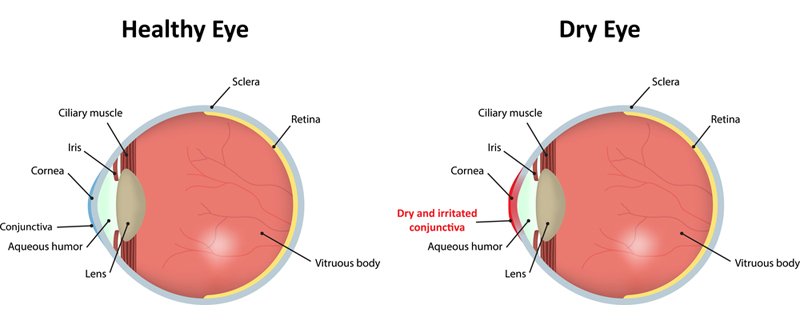Dry eye syndrome or tear film dysfunction is one of the most common side effects of laser vision correction. Almost all patients report symptoms suggestive of dry eyes after eye surgeries, including LASIK. It is because the surgery requires raising a corneal flap which results in cutting the nerves. These nerves on the surface of the cornea need to grow back after surgery which usually needs about six months.
Although dry eyes may cause a lot of symptoms, they do not cause any serious and permanent damage to the eyes, unless extremely severe.
The primary symptoms of dry eye include:
- Stinging, burning or scratchy sensation in the eyes
- Stringy mucus discharge from eyes
- Sensitivity to light that is intolerance of bright light, sunshine
- Persistent eye redness
- Foreign body sensation in the eyes, typically described as sand in the eyes
- Intolerance of contact lenses, watering, pain
- Difficulty with night time driving
- Blurred vision which fluctuates, usually getting better after blinking or closing eyes
- Tiredness of eyes and eye strain, especially in front of a computer
If you are a resident of Delhi NCR, we advice you to visit us and get a consultation with our eye specialist for your dry eyes.
Before Surgery
Identifying dry eyes before surgery, and meticulous attention and treatment during the planning of operation is essential. Proper care in the postoperative period leads to enhanced patient satisfaction and more accurate visual outcomes. Having dry eyes is not a contraindication for spectacle removal surgery. But doctors are extra cautious when operating on a patient with preexisting dry eyes and always consider the severity of the condition and the possibility of effective treatment before recommending a procedure.
Tests for detecting dry eyes include:
- Schirmer Test: A thin strip of special paper is placed under the lower eyelid to measure its wetting due to tear production.
- Tear breakup time: The doctor places a small amount of dye on the eye’s surface to monitor how tears “break up” on the eye’s surface.
- Imaging: Special instruments that provide a view of the tear film without touching the eye’s surface may be used.
- MMP-9 Testing: The doctor may collect a small tear sample tears from the inside of your bottom lid. High levels of an MMP-9 protein that can be measured in a laboratory can predict inflammatory dry eye after LASIK.
Predisposing factors for dry eyes include older age, allergy medications, certain blood pressure medications, contraceptive pills and anti-depressants, autoimmune diseases such as rheumatoid arthritis, collagen vascular disease, Sjogren’s syndrome, thyroid disease, etc.
Other contributing factors include:
- Decreased Corneal Sensitivity From Prolonged Contact Lens Wear
- Damage To Mucus Producing Goblet Cells From LASIK Suction Ring
- Decreased Corneal Sensations
- Reduced Blink Rate
- Inflammation of conjunctiva and eye surface due to use of postoperative drops
Surgical Options
After the preoperative assessment, the doctor may offer the patient the following options:
- Treatment for eyelid gland dysfunction and dry eyes before surgery is carried out
- Photorefractive Keratotomy, PRK: PRK a laser procedure for removal of glasses in which no corneal flap is raised initially, and some doctors believe it reduces the incidence of dry eye after surgery
- Thin flap LASIK or Sub-Bowman’s Keratomileusis, SBK: SBK uses a much thinner corneal flap, and is preferred because thinner flaps result in less disruption of corneal nerves, and therefore, dry eyes.
- Femtosecond LASIK: There is evidence that there is a lower incidence of LASIK related dryness in patients who have surgery using a femtosecond laser, that is “all laser blade-free LASIK”. It is because, in the femtosecond LASIK, the corneal flap is more precise and stable than that of the manual The rate of corneal abrasions and astigmatism are also lower with the blade-free technique.
Depending on patient profile, clinical findings, and the patient’s preference, the operating surgeon decides on the best course of action, before proceeding with surgery. The choice of operation is dependent on several other factors also, including refractive status, that is, the power of current glasses, corneal thickness, etc.
After Surgery
Most studies indicate that the clinical signs and symptoms of dry eye and decreased corneal sensation recover to preoperative levels approximately 6 months to 1 year after surgery. After LASIK, lubrication with nonpreserved tear supplements, topical corticosteroids, punctal occlusion, and topical cyclosporine 0.05% are recommended after surgery. In patients with preoperative dry eyes, their use may be more aggressive in various combinations depending on symptoms.
In case of persistent symptoms, most doctors start with tear replacement, using preservative free lubricating drops, adding an ointment if there is significant desiccation. If the patient uses more than six to eight drops per day, collagen plugs to prevent tear drainage maybe tried.
Other ancillary measures which help include warm compresses with gentle lid massage in case of eyelid gland dysfunction. Nutritional supplements including flax seed oil and omega three fatty acids may also help increase tear production. Use of humidifiers, protective goggles and avoiding extremely arid and dusty conditions may also provide relief in symptoms. Proper use of computers and screen devices with attention to the 20-20-20 rule may improve symptoms.

